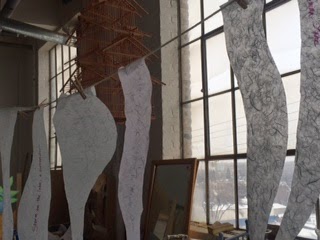 Joint Lab - December 23, 2014 by Susan Weinberg
Joint Lab - December 23, 2014 by Susan Weinberg
I must confess that I often take a deep breath before I begin one of these blogs. Our sessions are frequently so rich in content that I consider them much like a mountain climber in search of a foothold. Where to take that first step? Today my trek began with Torah and ended with Kaballah.
Rabbi Davis began our discussion with a simple question about the Torah. What is it? We began with descriptors; laws, values, 5 books, teachings, a cultural repository. Then we began to drill down to what it represents to us; our people's history, how we are unique, who we are and how we treat each other. Rabbi Davis noted that it begins with the story of a family of five generations. Then it follows us into Exodus as we become a nation, a people.
Torah means instruction, teaching. We noted that we are taught to question so it is a conversation starter, a living document that is still applicable today. It presents a model of behavior, choices and pathways.
The rabbi pointed us towards Exodus 15:22, a passage where Moses and the Israelites have emerged for the Red Sea. Miriam and the women have sung their song of praise to the Lord, dancing with timbrels. Now three days have gone by and they are in the wilderness of Marrar where the water is bitter. They cry out for fresh water. God points out some wood which Moses throws into the water and it sweetens it. What does this mean?
Perhaps we need to participate in miracles. They require our active involvement. It is not a remote God, but one who interacts with us. Participation is required.
Interestingly the Hebrew word for wood in this passage translates to the tree of life.
We reviewed Betachot 61b, a story of Rabbi Akiba where the water that fish live within is equated to study of Torah in its essential nature. Water is often used as a metaphor for knowledge. It is vast, much is hidden, offering life and nourishment, but also danger. You can drown in Torah if you fail to apply it to life. A story was shared which noted the importance of "hearing a baby cry", essentially staying connected to the world even in the midst of Torah study.
In the second part of our session Joy Gordon introduced us to Kaballah. Kaballah means "that which has been received" and is part of a lengthy Jewish mystical tradition.
Some of the key concepts in Kaballah are interconnectedness, flow between points of connection, balance, boundaries/containers and multiple levels of reality. The story which embeds many of these concepts begins with "the infinite". God contracts, creating space within the infinite, a withdrawal called the Tzimtzum. Within that vacuum light enters, refracts into ten Sefirot and shatters vessels of light because of its intensity. The breaking of vessels symbolizes the disorder of the world. The shards became sparks of light trapped in the material of creation. Tikkun is our effort to restore the world through good deeds and study of Torah.
The key concepts relate closely to water. Water requires a container and finds it in lakes, river beds, oceans and clouds. It flows from higher to lower. Balance is necessary also lest we have floods or drought. Much of water is hidden as in icebergs or wells.
Joy shared with us the cosmology outlined by Isaac Luria who lived after the expulsion from Spain. The components of this cosmology include the following concepts:
Keter-crown
Chochmah-wisdom, can represent the flash of an idea
Binah-understanding, represents building,developing
Da'at -knowledge ( not one of the ten Sephirot, but central none the less)
Chesed-grace
Gevurah- Judgment, boundaries/containers
Tiferet-Beauty, balance, harmony
Hod-glory, pulling back to make a space, to appreciate something, how does it feel, look, to be in awe of what is there, editor, refinement
Nezach-victory, energy that keeps you moving towards your goal, passion
Yesod-foundation of your work, ego, a secret part of you may be embedded in your work.
Malchut-manifests in everyday world when hanging on wall
With this structure in mind we considered how it applied to the artistic process. To create requires a space, but a space on many levels- a physical space, an emotional space, an intellectual space and a spiritual space. We may use a studio or a room in our home. Perhaps we clear our mind by going for a walk. Many of us struggle to clear our minds of activity and find such mundane tasks as washing the dishes or straightening up make the necessary space for creative ideas to emerge. Some shared that their best ideas arise when they are doing something totally unrelated.
In any case the creative act requires differentiation. We cannot create without first creating space for a dialogue with our emerging artwork. Just as when we lead a discussion, we need to leave space to engage others, to make room for the unknown. And we need something or someone else with whom we create dialogue.
With a flash of an idea (Chochmah) we move into developing it (Binah). Perhaps we temporarily suspend judgment (Gevurah) while we allow our eye for color and form (chesed) to move it forward, only then evaluating it through the more critical eye of Gevurah. Our application of both Chesed and Gevurah hopefully achieves balance and harmony (Tiferet). Then we take a step back and create space (Hod). I think of how I set my painting across the room, positioned by the door so I can see it through fresh eyes when I enter the studio. We are pleased with our result, we've succeeded (Nezach). Perhaps within it lies a part of the artist (Yesod) and ultimately we share it with others (Malchut).
From Torah to Kaballah, quite a mountain for one session.





















